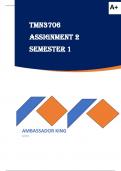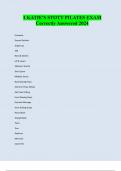A+
Tmn3706
assignment 2
SEMESTER 1
AMBASSADOR KING
ADMIN
, TMN3706 Assignment 2 (COMPLETE ANSWERS) 2024 (530293)- DUE 24
June 2024;100% TRUSTED workings, explanations and solutions. for
assistance Whats-App.............
1.1. Discuss Bloom’s taxonomy of learning in the cognitive domain. (25)
Bloom's taxonomy is a framework used to classify educational objectives into levels of
complexity and specificity. Developed by Benjamin Bloom in 1956, it has become a
foundational tool for educators to design and assess learning outcomes. Bloom's
original taxonomy consisted of three domains: cognitive, affective, and psychomotor.
Here, let's delve into Bloom's taxonomy specifically in the cognitive domain:
1. Remembering: At the base of the pyramid is remembering. This involves
recalling facts, terms, basic concepts, and answers. Memorization is the key
aspect here. Examples include listing, defining, identifying, and naming.
Assessments might involve multiple-choice questions, matching exercises, or
simple recall tasks.
2. Understanding: Understanding moves beyond mere memorization. Learners
grasp the meaning of information by interpreting, explaining, and summarizing.
This level involves comprehension of ideas and concepts rather than just rote
memorization. Examples include interpreting, summarizing, explaining, and
classifying. Assessments could involve short answer questions, essays, or
explanations of concepts.
3. Applying: Applying requires the learner to use acquired knowledge in new and
concrete situations. This might involve solving problems, using acquired
knowledge in new contexts, or applying procedures to given situations. Examples
include problem-solving, using information in a new context, and implementing
procedures. Assessments could include practical exams, case studies, or
simulations.
4. Analyzing: Analyzing involves breaking down information into its components to
understand its structure and relationships. Learners examine information and
identify patterns, relationships, or underlying principles. Examples include
comparing, contrasting, dissecting, and categorizing. Assessments could involve





